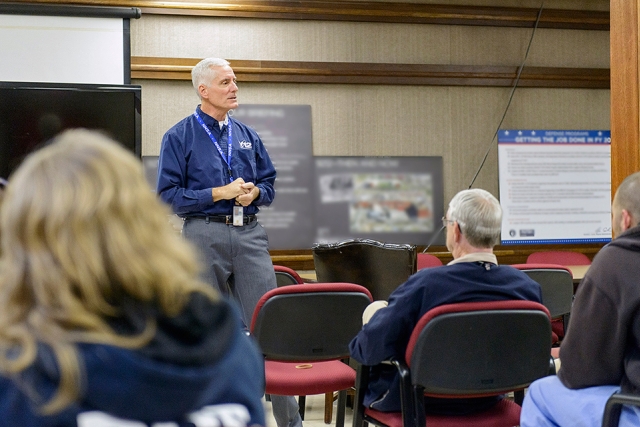Taking the One-Metric-Ton Challenge
 NNSA Uranium Program Manager Tim Driscoll speaks with the One-Metric-Ton Challenge team in Building 9212. The team has undertaken an extensive dedicated maintenance effort to improve metal production equipment reliability and reduce unexpected down time, with an end goal of significantly increasing purified metal production by fiscal year 2017.
NNSA Uranium Program Manager Tim Driscoll speaks with the One-Metric-Ton Challenge team in Building 9212. The team has undertaken an extensive dedicated maintenance effort to improve metal production equipment reliability and reduce unexpected down time, with an end goal of significantly increasing purified metal production by fiscal year 2017.
Last year, NNSA Uranium Program Manager Tim Driscoll challenged Consolidated Nuclear Security, LLC to develop a clear plan to produce 1000 kg per year of purified uranium metal, a significant increase over goals from recent years. Rather than attack the challenge from the production side by increasing shifts and demanding more throughput, the One-Metric-Ton Challenge team approached it from a different angle.
The team — consisting of members from Engineering, Production, Program Management and Maintenance — proposed that their response to the challenge focus first on the biggest obstacle to producing any amount of purified metal at all: the equipment.
“Building 9212 has had issues with maintaining process equipment in recent years,” Senior Technical Advisor Susan Kozemko said. “The equipment often breaks down, causing unscheduled production shutdowns and excessive downtime for repairs.”
Given the lack of redundant equipment and the batch nature of processing operations, combined with so many unexpected shutdowns and delays, all equipment availability has been utilized for production runs. The tradeoff from this approach is a backlog of more than 200 corrective maintenance work orders related to 9212’s metal production equipment.
Portions of the facility will need to remain operational until 2025, after the Electrorefining project in Building 9215 and the new Uranium Processing Facility have come on-line. “We realized that much of the equipment in 9212 needs to be maintained for up to 10 more years of operating life,” Kozemko said.
To make that happen, in October 2015, Y-12 established a maintenance crew, consisting of nine full-time maintenance craft and two work planners, dedicated solely to reducing the 9212 maintenance backlog and ensuring the equipment remains viable as long as possible. Additional supporting resources, including a radiological control technician and an issuing authority, should be in place by the end of the year to complete the dedicated maintenance crew.
The crew will take an outage approach to executing maintenance activities. Instead of addressing issues individually and only as problems appear, the crew will isolate entire systems at a time, and during that outage, address all possible corrective and preventive maintenance issues before returning the system to operation.
“The first outage is nearing completion, and the second is underway,” Kozemko noted. “All maintenance outage activities are coordinated with the facility’s production goals and with other facility activities to provide the least possible impact to ongoing work.”
Additionally, through corporate reach-back, Lockheed Martin experts are evaluating the maintenance efforts and will provide recommendations on critical spares to be established; preventive maintenance program enhancements; consolidation of equipment; and other improvements in maintenance strategies, supporting systems, procedures and practices.
With the focus now on improving system reliability, the original One Metric Ton Challenge has been redefined as the “Purification Challenge.” Ultimately, the team hopes to significantly reduce the number of unscheduled outages and unanticipated downtime for repairs. That, in turn, should allow for sustained operation and increased throughput, with plans to significantly increase purified metal production and meet Driscoll’s challenge by FY2017.
On a recent visit to Y-12, Driscoll stopped by to chat with the team and highlight the importance of their task. “He emphasized the importance of the team’s efforts to place our uranium product in a safer form — purified metal — thereby reducing safety and mission risk for Y-12 as a whole,” Kozemko said. “He also relayed the need to provide a stockpile of material to help mitigate risks associated with new processes, new facilities and future mission requirements.”
